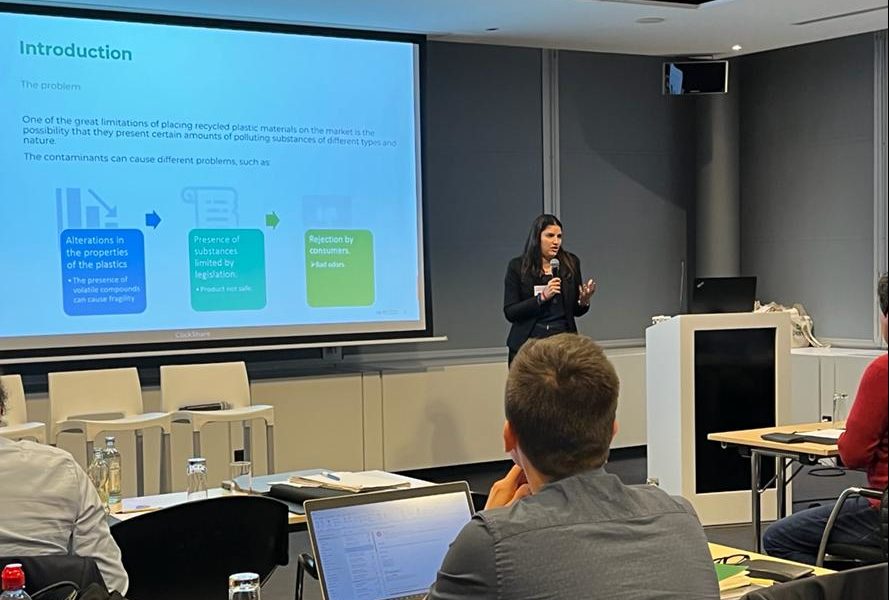The CIMPA workshop on “Innovative solutions for the circularity of plastic films” was held on 3 November in Brussels. During this event, AIMPLAS presented the strategies used within the CIMPA project to improve the quality of post-consumer recycled plastics.
Main limitation of placing recycled plastic materials on the market is the possibility that they present certain amounts of polluting substances of different types and nature. These contaminants can cause different problems, such as alterations in the properties of the plastics, the presence of substances limited by legislation and rejection by consumers. Household waste stream usually contains contaminants such as plastic additives, inks, incompatible polymers, as well as organics residues.

Potential contaminants can come from contact with content (food, detergents, oils, etc.), circular or linear oligomers from incomplete polymerization or deterioration of polymer during recycling process, additives, and their products of degradation (inks, adhesives, coatings…), contaminants from non-food plastics and misuse by consumer.
Carrying out the decontamination of the recycled plastic material makes it possible to eliminate, or at least reduce, the presence of substances that may imply certain limitations. For this purpose it is necessary to identify and quantify those contaminants that may be present in recycled materials. Also, to develop specific decontamination strategies at the end-of-life with the aim of obtaining safe and quality recycled material, maintaining processability and mechanical properties.
The standard recycling process, applied to most plastic waste streams, after proper collection and sorting, consist in the following steps:
1. Pre-treatment of recycle material: Pre-rinsing, crushing, washing (different washing agents, detergents, surfactants), and subsequent rinsing and drying.
2. Pelletizing in an extrusion line to obtain a new material.
In standard pelletizing systems the devolatilization can be limited, and together with the high temperatures used by recyclers to ensure al polymers are melted (these consisting in non-separable components such as barriers, lids, inserts, etc.), the volatile content, thus odors, are usually very high and distinctive.
To assess this issue, two technologies are being tested and optimized in CIMPA:

Devolatilization is a complex process, which depends on multiple parameters such as temperature profile, shear profile, screw configuration, placement of venting, residence time, among others. Several stripping agents can be added to improve the devolatilization, which are turned into gas phase inside the extruder, and then the bubbles are dispersed in the melt to form a micro-foam with specific surface area and, therefore, high capacity for transfer and diffusion of contaminants is achieved.
A special type striping agents are supercritical fluids, the most used being carbon dioxide. In the supercritical region, the fluid exhibits particular properties and has an intermediate behavior between that of a liquid and a gas. In particular, supercritical fluids (SCFs) possess liquid-like densities, gas-like viscosities and diffusivities intermediate to that of a liquid and a gas. If gases are used in supercritical conditions, these conditions must achieve and maintain inside the machine.
In CIMPA project the following strategies are being implemented:
· Adjustment of process conditions to improve decontamination efficiency
· VOC removal of multilayer agricultural films (PE/PA, PE/EVOH), and household waste film (PE/PET and PE/PA).
· Residual solvent removal from polyolefins, after physical recycling process
· One-step additivation (stabilization) during decontamination to avoid further degradation of recyclates and reduce thermal history.
Some of the results obtained so far for post-consumer agricultural waste, e. g. with the use of Sc CO2, show a reduction in VOC content of 75% respect to control.

In the upcoming month of the project, the methodology developed will be applied to post-consumer waste. Additional optimization will also take place, in order to recude the VOC further more.
Vanessa Gutiérrez Aragonés
Mechanical Recycling Group – AIMPLAS